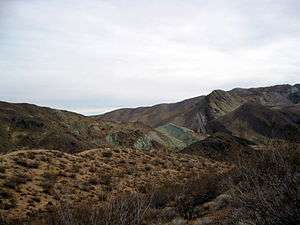Jawbone Canyon

Jawbone Canyon is a geographic feature in the Mojave Desert and a Bureau of Land Management area located in Kern County, California. Located 20 miles north of Mojave on CA 14, the area is a popular destination for hikers and off road vehicle enthusiasts.
History
Europeans first settled in the canyon around 1860—naming it Jawboner because its shape resembled a mandible[1]—and the trail was used as a trade route from Keyesville into the Piute Mountains. During the Kern River gold rush, several gold mines operated in the canyon; the most successful of these, the St. John mine, yielded nearly $700,000 worth of gold between 1860 and 1875. The Gwynn mine, on the Geringer Grade, ran six claims yielding a total of $770,000 worth of gold and quartz before ceasing operations in 1942. Mining continued throughout the 1940s, mainly focused on rhyolite and antimony.[2]
The area has been used for recreation since the early 20th century. A scientific study, published in 1983, shows that extensive environmental damage had been caused by off road vehicles operating in Jawbone Canyon.[3] Although off-roading is still permitted in the recreation area, as the Jawbone-Butterbredt Area of Critical Environmental Concern riders are restricted to established trails.[4]
Features
- The largest sag pipe of the Los Angeles Aqueduct crosses through Jawbone.[5]
- Blue Point, a large hill covered with blue-green stone, marks the entrance to Alphie Canyon. The color is due to oxidized copper in the rock.[6][7]
- The Tehachapi Pass Wind Farm is visible from the eastern end of the trail.[2]
- Jawbone Canyon road terminates at Piute Mountain road, inside Sequoia National Forest.
- Jawbone-Butterbredt Area of Critical Environmental Concern
See also
Articles
Index
- Category: Flora of the California desert regions
- Category: Fauna of the Mojave Desert
- Category: Protected areas of the Mojave Desert
References
- ↑ Gudde, Erwin G.; Bright, William (2004). California Place Names. University of California Press. p. 183. ISBN 0-520-24217-3.
- 1 2 Massey, Peter; Wilson, Jeanne (2006). Backcountry Adventures Southern California. Adler Publishing. p. 187. ISBN 1-930193-26-2.
- ↑ Webb, Robert H.; Wilshire, Howard G. (1983). Environmental effects of off-road vehicles: impacts and management in arid regions. Springer-Verlag. ISBN 0-387-90737-8.
- ↑ Jenkins, Jim C.; Jenkins, Ruby J. (1992). Exploring the Southern Sierra. p. 28. ISBN 0-89997-128-8.
- ↑ "CA4933: Los Angeles Aqueduct Jawbone Canyon Siphon". Center for Land Use Interpretation. Archived from the original on November 21, 2008. Retrieved January 2, 2010.
- ↑ Huegel, Tony (2001). Sierra Nevada Byways: Backcountry Drives for the Whole Family. p. 52. ISBN 0-89997-273-X.
- ↑ Massey, Peter (2006). California Trails Central Mountains Region. Adler Publishing. p. 104. ISBN 1-930193-19-X.
External links
| Wikimedia Commons has media related to Jawbone Canyon. |
Coordinates: 35°19′N 118°02′W / 35.31°N 118.03°W





